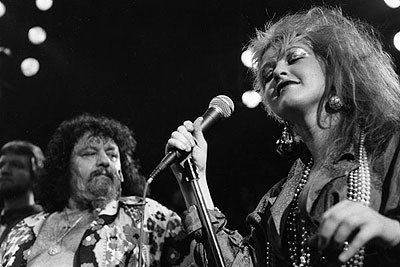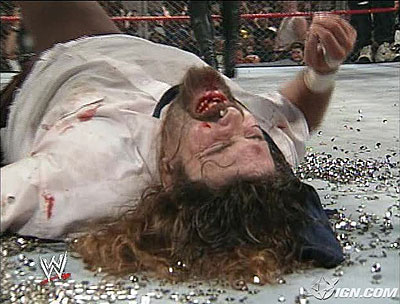Suffering, Defeat, and Justice: Why You Should Care About Pro Wrestling
Published on January 30th, 2012 in: Issues, Oh No You Didn't, Pro Wrestling, Sports, TV |By Paul Casey
Professional wrestling reached the high water mark of its popular and critical acceptance in the late 1990s. Since then, the Internet has bypassed the crude elitism of the dirt sheets and allowed fans the world over to step inside the shoes of a failed sports journalist with a disregard for both style and skill. When Vince McMahon admitted the pre-arranged nature of professional wrestling, he hit upon a unique way to market his World Wrestling Federation. “Sports Entertainment” is an athletic display, a “male” soap opera, a comedy showcase, and supposedly has more in common with Saturday Night Live than it does with Greg “the Hammer” Valentine vs. Roddy Piper in a Dog Collar Match.

Lou Albano, Cyndi Lauper
This was probably true in the 1980s, when Cyndi Lauper was palling around with Lou Albano and Mr. T was teaming with Hulk Hogan. It was probably true in the late ‘90s when The Rock and Steve Austin were at the top of their game. We’re a living cartoon. We’re real life super heroes. We’re a magic show. The successful marketing term of “Sports Entertainment” was an obvious, calculated attempt to redefine a business which had fallen between the cracks of popular culture. “Do they really expect us to believe this is real?” Although people can appreciate the commitment of magicians such as Penn & Teller and David Blaine in maintaining the illusion, the confusion over what wrestling actually is led to a long period where the public liked to believe that they were simply too sharp to be fooled.
“Sports Entertainment” is often mocked by “hardcore” wrasslin’ fans for being in some way inauthentic. For the majority of its existence however, “Professional Wrestling” has been a misnomer of considerable note. The structure and art form of pro wrestling, although encompassing many elements of the sport of wrestling, is no more a professional expression of this Olympic endeavor than Monday Night Raw is appreciated by The New Yorker for its deep character studies.
While “Sports Entertainment” allowed Vince McMahon, Eric Bischoff, and now Dixie Carter to speak of their product in a somewhat honest way and to court pop culture, it also allowed those who resented the re-branding to rebel against it in a revivalist fashion. The original Paul Heyman led-ECW (first Eastern Championship Wrestling, then Extreme Championship Wrestling) was in many ways just that. Even as ECW rejected the corporate adoption of pro wrestling by Ted Turner and Vince McMahon, and stressed the “in-ring work” as being of utmost importance, Heyman was resolutely modern in how he presented it.
“Kayfabe” refers to the way in which wrestlers, promoters, and performers maintain their personas in public, in order to further the investment of the audience in the stories which are being told. The reasoning was that if the public believed that characters actually hated each other in reality, then they would be more likely to pony up the cash to see them fight. While it is perhaps overestimated how many people actually believed in the “reality” of wrestling pre-1980s, there is no doubt that the lack of intimate knowledge of the mechanics of how matches were constructed allowed a greater degree of doubt, when members of the audience were unsure of what did or did not hurt. The abandonment of “kayfabe” has led to an escalating level of danger and violence from the ‘80s onwards.
While ECW did feature an array of styles, it was fixated on an overtly bloody and dangerous form of wrestling. ECW adopted the excesses of the Japanese and Mexican styles and incorporated them into a shamelessly vulgar product. Paul Heyman and ECW in this way established the standard for wrestling in the mid-to-late-‘90s. No longer could a chair shot be considered worthy of ending a match. Ten chair shots to the head was now the standard bearer. As Jim Cornette quite elegantly stated on his blog:
“So what has been the fallout of ‘hardcore’ wrestling today? For the wrestlers, shorter careers, higher injury rates, and painkiller addictions. The fans have been numbed to seeing people get hit with objects, so you have to hit someone THREE times as hard to get a THIRD of the response. Twenty years ago, we PRETENDED to hurt each other, and the fans believed it. Today, we REALLY DO hurt each other, and the fans think it’s fake.”

Mick Foley
Time limit is exhausted. Please reload the CAPTCHA.